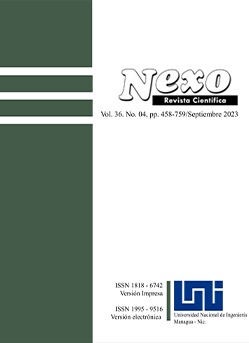Evaluation of seismic performance and design of AAC building systems (autoclaved aerated concrete) with different reinforcement methods
DOI:
https://doi.org/10.5377/nexo.v36i04.16774Keywords:
autoclaved lightweight concrete, compressive strength, partial damage threshold, low thermal coefficient, steel reinforcements, different reinforcement methodsAbstract
Autoclaved lightweight concrete was produced for the first time in Sweden and after several decades, it has been widely used in most of the industrialized countries of the world, especially in the construction industry. Lightness, effect in reducing forces caused by earthquakes, ease of implementation, low thermal coefficient, fire resistance and sound insulation are among the undeniable advantages of this product. The use of this concrete is very effective in optimizing fuel and energy consumption, and its high compressive strength is considered an important feature, to the extent that it has been recognized as a desirable and suitable product in the construction industry. Obviously, with the growth of demand increasingly, using traditional methods and materials for housing production in Iran is not very effective. Compilation of criteria for the design and implementation of a gravity-bearing and lateral structural system made of AAC autoclaved aerated concrete products (including reinforced blocks and panels) The structure is made based on valid international regulations and considering Iran's seismic standards as follows. Roof and floor design using reinforced AAC roof panels and the combination of AAC roof blocks and regular concrete in place reinforced with steel reinforcements after examining the principles and foundations and modeling based on logical engineering principles and assumptions to compare the results and the outputs of the software have paid. Based on the available results, we can see the effect of the number of floors, plan and height of the floor on the behavior of the structure. According to the values in the table, the probability of the structure passing through the threshold of minor, moderate, and advanced damage is examined in different states. 1- The probability of passing a 1-story structure compared to a 2-story structure from the threshold of partial, moderate, and advanced damage has decreased by 59.7%, 94.5%, 99.3, and 99.8%, respectively. 2- The probability of passing a 2-story structure compared to a 3-story structure It reduces the threshold of partial, moderate, and advanced damage by 55.7%, 93.2%, 99.0%, and 99.7%, respectively.
Downloads
1572
Downloads
Published
How to Cite
Issue
Section
License
Copyright (c) 2023 Universidad Nacional de Ingeniería

This work is licensed under a Creative Commons Attribution 4.0 International License.
The authors who publish in Nexo Scientific Journal agree to the following terms:
- Authors retain the copyright and grant the journal the right of the first publication under the license Creative Commons Attribution License, which allows others to share the work with a recognition of the authorship of the work and the initial publication in Nexo Scientific Journal.
- Authors may separately establish additional agreements for the non-exclusive distribution of the version of the work published in the journal (for example, in an institutional repository or a book), with the recognition of the initial publication in Nexo Scientific Journal.
- Authors are allowed and encouraged to disseminate their works electronically (for example, in institutional repositories or in their own website) before and during the submission process, as it can lead to productive exchanges, as well as earlier and greater citation of published works.










